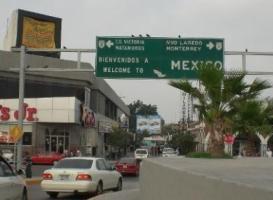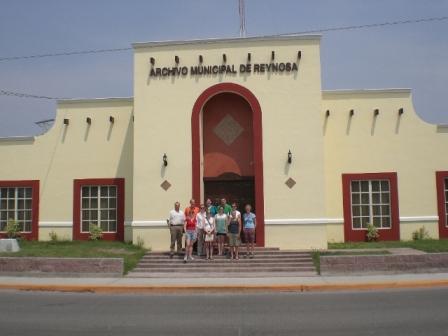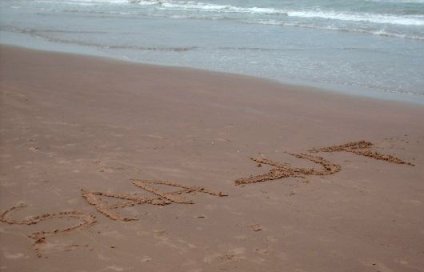Rio Grande River Valley Trip
From Saaut
(→Day Three) |
|||
| Line 1: | Line 1: | ||
| - | <table align= | + | <table align=center border=1 cellpadding=0 cellspacing=0><tr><td>http://www.ischool.utexas.edu/~saa/images/photos_2008-2009/mexico/Border.jpg</td></tr></table> |
In the spring of 2008, ten SAA-UT members took a trip to the Rio Grande River Valley to explore archives and towns in southern Texas in the USA and northern Tamaulipas in Mexico. | In the spring of 2008, ten SAA-UT members took a trip to the Rio Grande River Valley to explore archives and towns in southern Texas in the USA and northern Tamaulipas in Mexico. | ||
| Line 9: | Line 9: | ||
After a six hour drive, the first destination was reached: [http://www.ischool.utexas.edu/~saa/images/photos_2008-2009/mexico/WillieBs.jpg Willie B's Barbecue] in Edinburg, TX. Joining us for lunch were '''George Gause''', Special Collections Librarian at [http://www.lib.utpa.edu/collections UT-Pan American's Special Collections Library], and '''Barbara Stokes''', the Senior Curator of Archives, Collections, and Programs at the [http://www.mosthistory.org Museum of South Texas History] (MOSTH)'s [http://www.mosthistory.org/Archives Margaret H. McAllen Memorial Archives]. | After a six hour drive, the first destination was reached: [http://www.ischool.utexas.edu/~saa/images/photos_2008-2009/mexico/WillieBs.jpg Willie B's Barbecue] in Edinburg, TX. Joining us for lunch were '''George Gause''', Special Collections Librarian at [http://www.lib.utpa.edu/collections UT-Pan American's Special Collections Library], and '''Barbara Stokes''', the Senior Curator of Archives, Collections, and Programs at the [http://www.mosthistory.org Museum of South Texas History] (MOSTH)'s [http://www.mosthistory.org/Archives Margaret H. McAllen Memorial Archives]. | ||
| + | <table align=left border=1 cellpadding=0 cellspacing=0><tr><td>http://www.ischool.utexas.edu/~saa/images/photos_2008-2009/mexico/MOSTHstorage.jpg</td></tr></table> | ||
At the MOSTH, Ms. Stokes led us through the museum's artifact storage and processing area. Next, we moved to the McAllen Archives in the [http://www.ischool.utexas.edu/~saa/images/photos_2008-2009/mexico/ArchivesInOldJailBuilding.jpg Old Jail] to visit the [http://www.ischool.utexas.edu/~saa/images/photos_2008-2009/mexico/MOSTHreadingroom.jpg reading room], administrative offices, and [http://www.ischool.utexas.edu/~saa/images/photos_2008-2009/mexico/MOSTHstorage.jpg storage]. Stokes ended the tour with a walk through the Old Jail, including the school children's favorite - [http://www.ischool.utexas.edu/~saa/images/photos_2008-2009/mexico/HangingRoom.jpg the Hanging Room], where one murderer was hanged, and Museum displays, including the mammoth skeleton, replica of a southern steamboat, and [http://www.ischool.utexas.edu/~saa/images/photos_2008-2009/mexico/MOSTHgroup.jpg fun-time dress up for all the archivists]. | At the MOSTH, Ms. Stokes led us through the museum's artifact storage and processing area. Next, we moved to the McAllen Archives in the [http://www.ischool.utexas.edu/~saa/images/photos_2008-2009/mexico/ArchivesInOldJailBuilding.jpg Old Jail] to visit the [http://www.ischool.utexas.edu/~saa/images/photos_2008-2009/mexico/MOSTHreadingroom.jpg reading room], administrative offices, and [http://www.ischool.utexas.edu/~saa/images/photos_2008-2009/mexico/MOSTHstorage.jpg storage]. Stokes ended the tour with a walk through the Old Jail, including the school children's favorite - [http://www.ischool.utexas.edu/~saa/images/photos_2008-2009/mexico/HangingRoom.jpg the Hanging Room], where one murderer was hanged, and Museum displays, including the mammoth skeleton, replica of a southern steamboat, and [http://www.ischool.utexas.edu/~saa/images/photos_2008-2009/mexico/MOSTHgroup.jpg fun-time dress up for all the archivists]. | ||
| Line 17: | Line 18: | ||
On the morning of Saturday, May 10, George led everyone to the border town of Reynosa, Tamaulipas, Mexico. At our first stop, the [http://www.ischool.utexas.edu/~saa/images/photos_2008-2009/mexico/ElPastor.jpg Restaurant El Pastor], we met the manager; ate a breakfast buffet full of fruit, spicy tomato soup, eggs and burritos, and so many more delicious foods; and were entertained by beautiful wildlife. We then toured the town, walking through the [http://www.ischool.utexas.edu/~saa/images/photos_2008-2009/mexico/ReynosaStreets.jpg streets], visiting the [http://www.ischool.utexas.edu/~saa/images/photos_2008-2009/mexico/ReynosaPlaza.jpg plaza], and witnessing the local life and [http://www.ischool.utexas.edu/~saa/images/photos_2008-2009/mexico/ReynosaBus.jpg transportation]. | On the morning of Saturday, May 10, George led everyone to the border town of Reynosa, Tamaulipas, Mexico. At our first stop, the [http://www.ischool.utexas.edu/~saa/images/photos_2008-2009/mexico/ElPastor.jpg Restaurant El Pastor], we met the manager; ate a breakfast buffet full of fruit, spicy tomato soup, eggs and burritos, and so many more delicious foods; and were entertained by beautiful wildlife. We then toured the town, walking through the [http://www.ischool.utexas.edu/~saa/images/photos_2008-2009/mexico/ReynosaStreets.jpg streets], visiting the [http://www.ischool.utexas.edu/~saa/images/photos_2008-2009/mexico/ReynosaPlaza.jpg plaza], and witnessing the local life and [http://www.ischool.utexas.edu/~saa/images/photos_2008-2009/mexico/ReynosaBus.jpg transportation]. | ||
| - | We next journeyed to the [http://www.reynosa.gob.mx/amunicipal.html Reynosa Municipal Archives] (pictured | + | <table align=right border=1 cellpadding=0 cellspacing=0><tr><td>http://www.ischool.utexas.edu/~saa/images/photos_2008-2009/mexico/ReynosaMunicipalArchivesGroupPhoto.jpg</td></tr></table> |
| + | We next journeyed to the [http://www.reynosa.gob.mx/amunicipal.html Reynosa Municipal Archives] (pictured at right), where students were able to see and handle [http://www.ischool.utexas.edu/~saa/images/photos_2008-2009/mexico/RMAdoc.jpg Spanish colonial and military documents] from the 18th century. The [http://www.ischool.utexas.edu/~saa/images/photos_2008-2009/mexico/RMAstorage.jpg Archives] was founded in 2003 and divided into two collecting areas, local history and government. It includes a study room for researchers, with access to a computer database of many record fonds, the organization of which is largely based on subject, form, or creator. Most inquiries at the archives come from students studying the history of the area or from local journalists. Interestingly, the biggest challenge of the archives is to translate documents from old Spanish (and elaborate cursive) to be made available for use. | ||
Afrter crossing back to America, we visited the town of Hidalgo, Texas, which has the oldest standing courthouse in Texas. Then, on to the Pumphouse Museum, which once served the area by pumping water from the Rio Grande for local agricultural use, for a quick tour and video about the [http://www.ischool.utexas.edu/~saa/images/photos_2008-2009/mexico/PumphouseSign.jpg pumphouse's history]. | Afrter crossing back to America, we visited the town of Hidalgo, Texas, which has the oldest standing courthouse in Texas. Then, on to the Pumphouse Museum, which once served the area by pumping water from the Rio Grande for local agricultural use, for a quick tour and video about the [http://www.ischool.utexas.edu/~saa/images/photos_2008-2009/mexico/PumphouseSign.jpg pumphouse's history]. | ||
Revision as of 01:44, 10 June 2008
 |
In the spring of 2008, ten SAA-UT members took a trip to the Rio Grande River Valley to explore archives and towns in southern Texas in the USA and northern Tamaulipas in Mexico.
Day One
On Friday, May 9, ten archival students hopped in their cars at 6:00 AM and left the city of Austin.
After a six hour drive, the first destination was reached: Willie B's Barbecue in Edinburg, TX. Joining us for lunch were George Gause, Special Collections Librarian at UT-Pan American's Special Collections Library, and Barbara Stokes, the Senior Curator of Archives, Collections, and Programs at the Museum of South Texas History (MOSTH)'s Margaret H. McAllen Memorial Archives.
 |
At the MOSTH, Ms. Stokes led us through the museum's artifact storage and processing area. Next, we moved to the McAllen Archives in the Old Jail to visit the reading room, administrative offices, and storage. Stokes ended the tour with a walk through the Old Jail, including the school children's favorite - the Hanging Room, where one murderer was hanged, and Museum displays, including the mammoth skeleton, replica of a southern steamboat, and fun-time dress up for all the archivists.
George Grause brought us to UT-Pan American to lead a tour of the Special Collections Library, including the John H. Shary Room, Rare Books, Archives, and other areas.
Day Two
On the morning of Saturday, May 10, George led everyone to the border town of Reynosa, Tamaulipas, Mexico. At our first stop, the Restaurant El Pastor, we met the manager; ate a breakfast buffet full of fruit, spicy tomato soup, eggs and burritos, and so many more delicious foods; and were entertained by beautiful wildlife. We then toured the town, walking through the streets, visiting the plaza, and witnessing the local life and transportation.
 |
We next journeyed to the Reynosa Municipal Archives (pictured at right), where students were able to see and handle Spanish colonial and military documents from the 18th century. The Archives was founded in 2003 and divided into two collecting areas, local history and government. It includes a study room for researchers, with access to a computer database of many record fonds, the organization of which is largely based on subject, form, or creator. Most inquiries at the archives come from students studying the history of the area or from local journalists. Interestingly, the biggest challenge of the archives is to translate documents from old Spanish (and elaborate cursive) to be made available for use.
Afrter crossing back to America, we visited the town of Hidalgo, Texas, which has the oldest standing courthouse in Texas. Then, on to the Pumphouse Museum, which once served the area by pumping water from the Rio Grande for local agricultural use, for a quick tour and video about the pumphouse's history.
Driving to Brownsville, students got to view the southern Texas landscape with fields of sugarcane and sorgum, small town communities, and beautiful churches. Once arriving, we immediately crossed the border and arrived in the town of Matamoros, Tamaulipas, where George gave us a tour, and we spent the night in the Hotel Colonial.
 |
Day Three
On the final morning of our trip, the group crossed back into America at Brownsville, where we said goodbye to George.
Then, we drove on to South Padre Island and went on a Dolphin Tour. After a delicious lunch came the sea Turtle Rescue with turtles of all kinds, large and small, and the beach. Finally, we all parted ways and returned to Austin.
